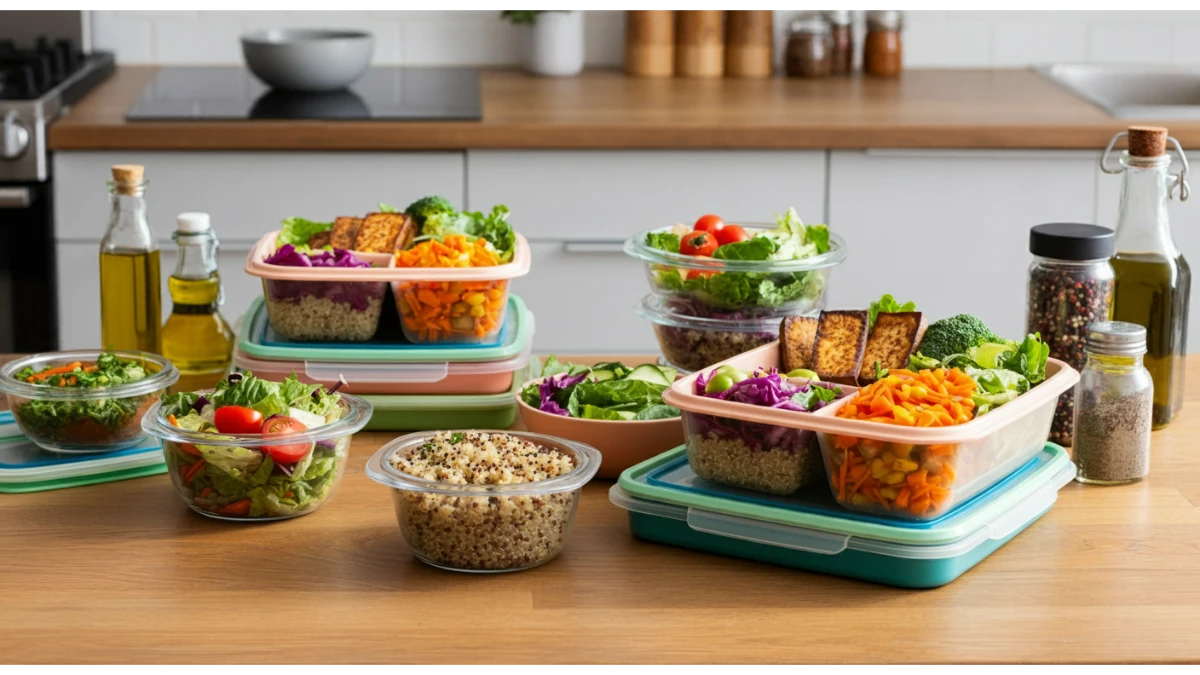Transform Your Plate: 5 Powerful Vegetarian Meal Prep Ideas for a Vibrant Life
Meal prepping is a fantastic way to save time, reduce stress, and eat healthily throughout the week. As a vegetarian, planning your meals in advance can help you stay on track with your dietary goals while enjoying a variety of delicious flavors and textures. In this article, I will share 5 easy vegetarian meal prep ideas that are not only nutritious but also simple to prepare. Whether you’re looking for breakfast, lunch, or dinner options, these recipes will keep you satisfied and energized all week long.
Key Aspects of Vegetarian Meal Prep
- Time Efficiency: Meal prepping can save you hours in the kitchen each week. By dedicating a few hours on the weekend, you can prepare meals for the entire week, allowing you to focus on other tasks during busy weekdays. The key to successful meal prep lies in organization and planning.
- Cost-Effectiveness: Preparing meals at home allows you to buy ingredients in bulk and reduce food waste. This approach can lead to significant savings compared to dining out or purchasing pre-packaged meals. When you meal prep, you can take advantage of seasonal produce and sales, further stretching your grocery budget.
- Health Benefits: When you meal prep, you can control the ingredients in your meals, ensuring they are nutritious and aligned with your dietary preferences. This control helps you maintain a balanced diet and avoid unhealthy choices. Plus, cooking at home often means less sodium, sugar, and unhealthy fats than restaurant meals.
- Variety and Creativity: Meal prepping encourages you to explore new recipes and ingredients. This variety keeps your meals exciting and prevents boredom from eating the same thing repeatedly. You can experiment with different cuisines and flavors, making healthy eating an enjoyable experience.
- Portion Control: Preparing meals in advance allows you to manage portion sizes, helping you stick to your dietary goals and avoid overeating. This is especially helpful for individuals aiming to shed pounds or sustain a healthy way of living.
1. Quinoa and Black Bean Salad
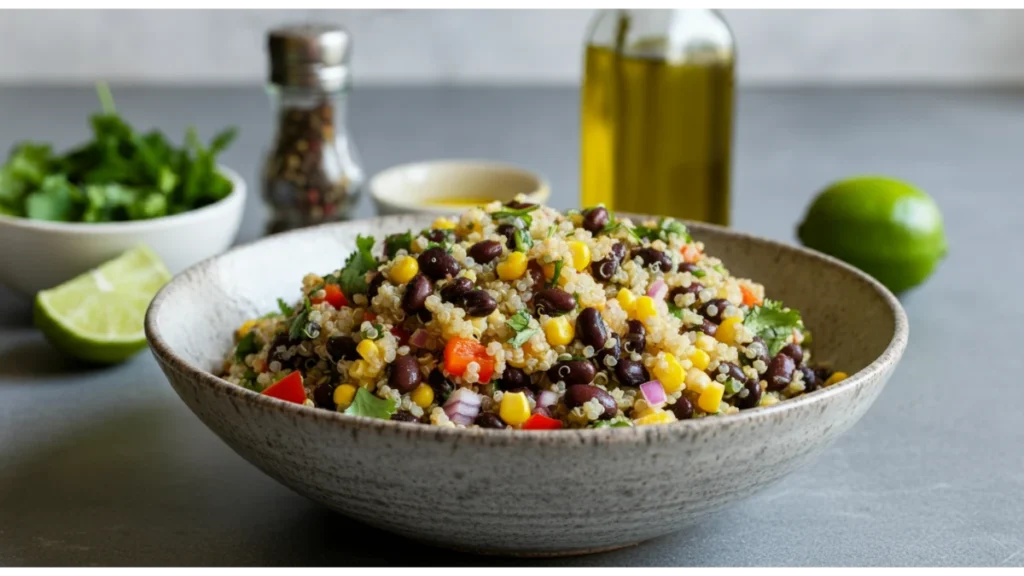
Ingredients:
- 1 cup quinoa
- 1 can black beans, rinsed and drained
- 1 bell pepper, diced (any color)
- 1 cup corn (fresh or frozen)
- 1/4 cup red onion, finely chopped
- 1/4 cup cilantro, chopped
- Juice of 2 limes
- 2 tablespoons olive oil
- Salt and pepper to taste
Instructions:
- Prepare the Quinoa: In a medium saucepan, mix the quinoa with 2 cups of water. Bring it to a boil, then lower the heat, cover, and let it simmer for 15 minutes, or until the water has been absorbed and the quinoa is light and fluffy.
- Combine Ingredients: In a large bowl, combine the cooked quinoa, black beans, diced bell pepper, corn, red onion, and chopped cilantro.
- Prepare the Dressing: In a small bowl, combine lime juice, olive oil, salt, and pepper. Drizzle the dressing over the salad and mix well to ensure everything is coated.
- Store: Divide the salad into meal prep containers. This salad can be stored in the refrigerator for up to 5 days, making it a perfect option for grab-and-go lunches.
Why It’s Great: This salad is packed with protein and fiber, making it a filling option for lunch or dinner. The fresh ingredients and zesty lime dressing keep it vibrant and refreshing. Plus, it’s versatile; you can add avocado, cherry tomatoes, or even feta cheese for extra flavor.
2. Vegetable Stir-Fry with Tofu

Ingredients:
- 1 block firm tofu, pressed and cubed
- 2 cups of assorted vegetables (broccoli, bell peppers, carrots, snap peas)
- 2 tablespoons soy sauce or tamari (for gluten-free)
- 1 tablespoon sesame oil
- 1 tablespoon ginger, minced
- 2 cloves garlic, minced
- Cooked brown rice or quinoa for serving
Instructions:
- Prepare the Tofu: Begin by pressing the tofu to eliminate excess moisture. Encase it in a clean kitchen towel and place a heavy object on it for approximately 15 minutes.
- Cook the Tofu: In a large skillet or wok, heat sesame oil over medium heat. Add the cubed tofu and cook until it achieves a golden brown color on all sides, around 8-10 minutes. Take the tofu out of the skillet and set it aside.
- Stir-Fry the Vegetables: In the same skillet, add ginger and garlic, sautéing for about 1 minute until fragrant. Incorporate the assorted vegetables and stir-fry for 5-7 minutes until they become tender-crisp.
- Combine: Combine everything and cook for another 2-3 minutes until everything is warmed through.
- Serve: Serve over cooked brown rice or quinoa and portion into meal prep containers.
Why It’s Great: This stir-fry is quick to make and can be customized with your favorite vegetables. Tofu serves as an excellent source of protein, making this dish ideal for a fulfilling dinner. You can also switch up the sauce with teriyaki or sweet and sour for different flavor profiles.
3. Chickpea and Sweet Potato Curry
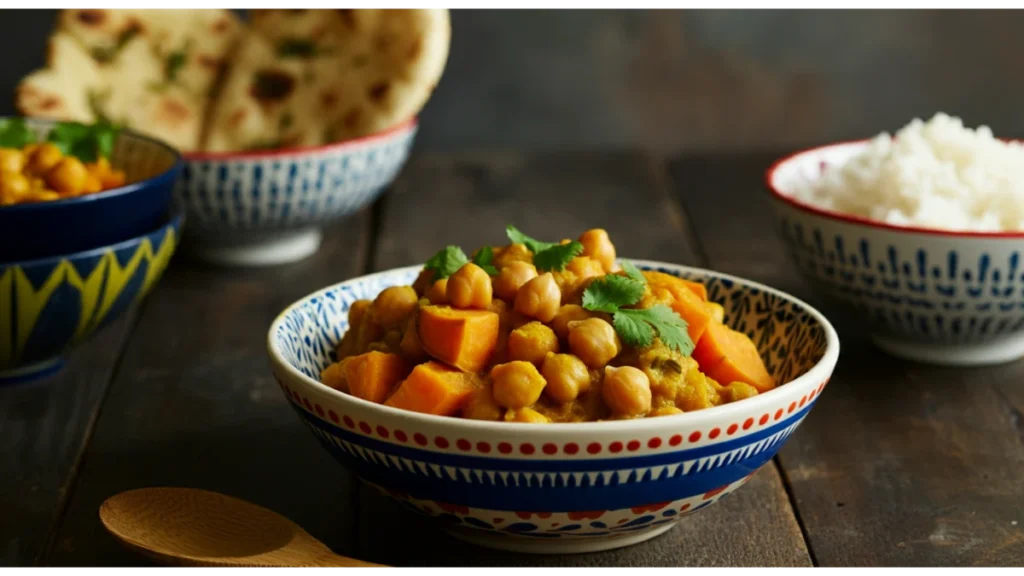
Ingredients:
- 1 can chickpeas, rinsed and drained
- 1 medium sweet potato, diced
- 1 can coconut milk
- 1 tablespoon curry powder
- 1 teaspoon cumin
- 1 onion, chopped
- 2 cloves garlic, minced
- 1 tablespoon olive oil
- Fresh cilantro for garnish
Instructions:
- Sauté Aromatics: In a large pot, warm olive oil over medium heat. Add chopped onion and minced garlic, sautéing until translucent, about 5 minutes.
- Add Sweet Potatoes: Add the diced sweet potato, curry powder, and cumin. Stir for 2 minutes to coat the sweet potatoes with the spices.
- Simmer: Pour in the coconut milk and add the chickpeas. Bring to a simmer and cook for 15-20 minutes, or until the sweet potatoes are tender.
- Garnish and Serve: Divide the curry into meal prep containers and garnish with fresh cilantro before serving. This dish pairs well with rice or naan.
Why It’s Great: This curry is creamy, comforting, and packed with flavor. It’s a complete meal that warms you up and is perfect for chilly nights. The combination of sweet potatoes and chickpeas provides a hearty texture that is both filling and nutritious.
4. Mediterranean Pasta Salad
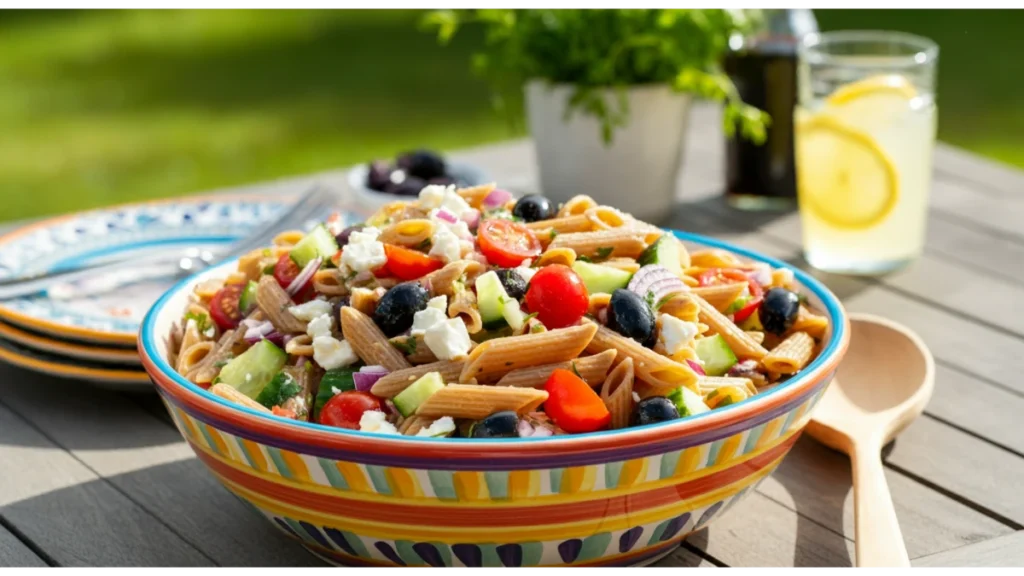
Ingredients:
- 8 oz whole wheat pasta
- 1 cup cherry tomatoes, halved
- 1/2 cup cucumber, diced
- 1/4 cup red onion, finely chopped
- 1/2 cup Kalamata olives, pitted and sliced
- 1/4 cup feta cheese (optional)
- 3 tablespoons olive oil
- 1 tablespoon red wine vinegar
- Salt and pepper to taste
Instructions:
- Cook the Pasta: Cook pasta according to package instructions. Drain and rinse under cold water to cool it off.
- Combine Ingredients: In a large bowl, combine the cooked pasta, cherry tomatoes, cucumber, red onion, olives, and feta cheese if using.
- Prepare the Dressing: In a small bowl, combine olive oil, red wine vinegar, salt, and pepper. Pour over the pasta salad and toss to combine.
- Chill and Store: Store the pasta salad in meal prep containers. It can be enjoyed cold and lasts up to 4 days in the refrigerator.
Why It’s Great: This pasta salad is fresh, vibrant, and perfect for lunch. It’s easy to make in bulk and can be served cold, making it a great grab-and-go option. The Mediterranean flavors are satisfying and can be enhanced with herbs like oregano or basil.
5. Lentil Soup
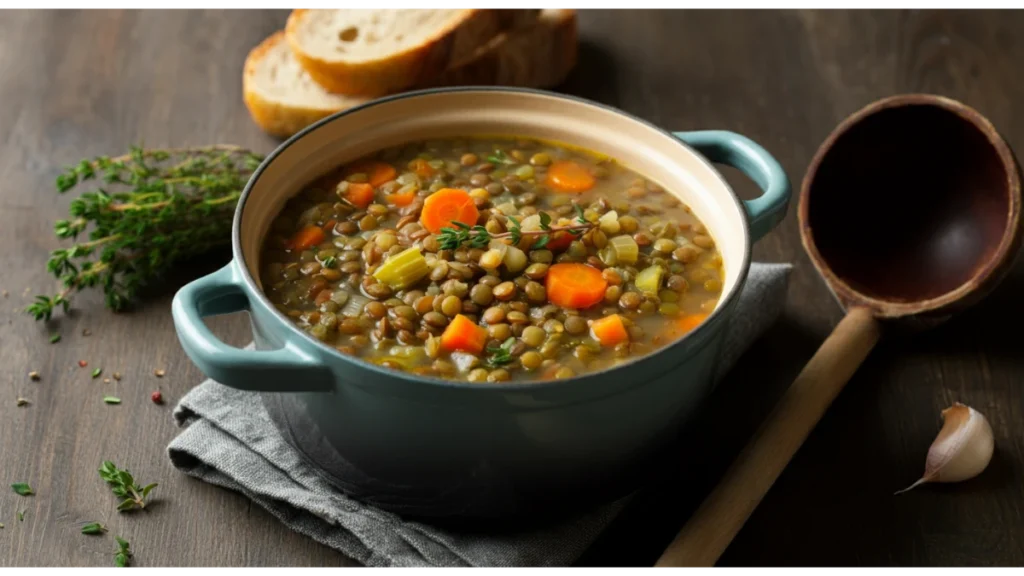
Ingredients:
- 1 cup lentils, rinsed
- 1 onion, chopped
- 2 carrots, diced
- 2 celery stalks, diced
- 3 cloves garlic, minced
- 6 cups vegetable broth
- 1 teaspoon thyme
- 1 bay leaf
- Salt and pepper to taste
Instructions:
- Sauté Vegetables: In a large pot, sauté onion, carrots, and celery in a bit of olive oil until softened, about 5-7 minutes.
- Add Garlic and Lentils: Add garlic and cook for an additional minute. Stir in the rinsed lentils, vegetable broth, thyme, bay leaf, salt, and pepper.
- Let it Simmer: Bring it to a boil, then reduce the heat and let it simmer for 30-40 minutes, or until the lentils are soft.
- Store: Remove the bay leaf and divide the soup into containers. It can be stored in the refrigerator or frozen for later.
Why It’s Great: This hearty soup is packed with protein and fiber from lentils, making it a filling and nutritious meal. It’s an excellent choice for meal prepping since it tastes even better the following day! Additionally, lentils are an excellent source of iron and folate.
Nutritional Value:
| Recipe | Key Nutrients | Benefits |
|---|---|---|
| Quinoa and Black Bean Salad | Protein, Fiber, Vitamins A & C | Supports digestion, boosts immunity |
| Vegetable Stir-Fry with Tofu | Protein, Vitamins K & C | Aids in bone health, promotes skin health |
| Chickpea and Sweet Potato Curry | Fiber, Healthy Fats, Iron | Supports heart health, boosts energy levels |
| Mediterranean Pasta Salad | Carbohydrates, Healthy Fats, Fiber | Provides sustained energy, aids digestion |
| Lentil Soup | Protein, Fiber, Folate | Supports heart health, promotes satiety |
Benefits of Vegetarian Meal Prep:
- Time-Saving: Preparing meals in advance allows you to enjoy healthy food without spending hours in the kitchen every day. You can batch cook and have meals ready to go, making it easier to stick to your dietary goals.
- Healthier Choices: By cooking at home, you can choose fresh, wholesome ingredients and avoid unhealthy additives often found in takeout or processed foods. Meal prepping encourages you to include more fruits, vegetables, and whole grains in your diet.
- Reduced Food Waste: Meal prepping helps you utilize ingredients fully, minimizing waste and optimizing your grocery budget. By planning your meals, you can ensure that you use up perishable items before they spoil.
- Better Portion Control: Pre-portioned meals make it easier to manage serving sizes, which is beneficial for weight management. By controlling your portions, you can avoid overeating and make healthier choices.
- Increased Variety: Planning meals encourages you to try new recipes and ingredients, keeping your diet interesting and balanced. This variety can help you get all the essential nutrients your body needs.
Future Trends in Meal Prep:
- Technology Integration: The use of apps for meal planning, grocery shopping, and recipe organization will continue to grow, making meal prep more accessible. Many apps now offer features that allow you to input your dietary preferences and generate customized meal plans.
- Sustainability Focus: More people are becoming aware of the environmental impact of their food choices, leading to increased interest in plant-based diets and local sourcing. Sustainable meal prepping will involve choosing seasonal produce and reducing packaging waste.
- Personalized Meal Plans: Customization based on dietary preferences, health goals, and lifestyle will become more prevalent, allowing individuals to create meal plans that suit their needs. This trend will likely include options for various dietary restrictions, such as gluten-free, vegan, or low-carb.
- Health and Wellness: As health consciousness rises, meal prep will increasingly focus on nutritional balance, incorporating superfoods and functional ingredients. Expect to see more recipes that include ingredients known for their health benefits, such as turmeric, chia seeds, and spirulina.
- Convenience Products: The market for pre-prepped ingredients and meal kits will continue to expand, catering to those who want to save time without sacrificing quality. These products can help simplify the meal prep process, making it easier for busy individuals to eat healthily.
Tips and Tricks Section:
- Batch Cooking: Cook large amounts of grains, proteins, and vegetables simultaneously. This approach saves time and ensures you have versatile ingredients on hand. For example, you can cook a big batch of quinoa and use it in salads, bowls, or as a side dish throughout the week.
- Use Quality Containers: Invest in airtight, stackable containers that are microwave and dishwasher safe. This will make storage and reheating easier. Glass containers are a great option as they are durable and do not retain odors.
- Plan for Snacks: Don’t forget to include healthy snacks in your meal prep, such as cut fruits, nuts, or yogurt, to keep your energy levels up throughout the day. Having snacks readily available can help prevent unhealthy snacking.
- Label Everything: Use labels to mark the contents and dates on your meal prep containers. This method allows you to monitor freshness effectively and reduces food waste. You can use masking tape and a permanent marker or invest in reusable labels.
- Mix and Match: Prepare ingredients that can be used in multiple recipes. For instance, roasted vegetables can be incorporated into salads, grain bowls, or wraps. Remember to try out various ingredients and flavors to keep your meals fun and enjoyable.
Variations and Adaptations:
- Gluten-Free: Substitute grains like quinoa or rice for pasta in recipes to make them gluten-free. You can also use gluten-free pasta options available in stores.
- Vegan: Ensure all ingredients, such as cheese and sauces, are plant-based to cater to vegan diets. For instance, use nutritional yeast instead of cheese for a cheesy flavor in pasta salads.
- Low-Carb: Focus on non-starchy vegetables and healthy fats. For example, use zucchini noodles instead of pasta and incorporate more leafy greens into your meals.
- Protein Boost: Add legumes, nuts, or seeds to salads and bowls for an extra protein kick. Chia seeds, hemp seeds, and pumpkin seeds are excellent options that can easily be sprinkled on top of meals.
- Flavor Enhancements: Experiment with different herbs and spices to customize flavors according to your preferences. Fresh herbs like basil, parsley, or dill can elevate the taste of your meals significantly.
FAQs Section:
Q: u003cstrongu003eCan I freeze meal prep meals?u003c/strongu003e
A: Yes, most meals can be frozen. Just ensure they are stored in airtight containers to prevent freezer burn. Soups, stews, and casseroles freeze particularly well.
Q: u003cstrongu003eHow long do meal prep meals last?u003c/strongu003e
A: Generally, they last 3-5 days in the refrigerator and up to 3 months if frozen. Always check for signs of spoilage before consuming.
Q: u003cstrongu003eWhat can I substitute for tofu?u003c/strongu003e
A: Tempeh, seitan, or beans can be great alternatives, depending on your dietary preferences. For a non-soy option, consider using jackfruit or mushrooms for a meaty texture.
Q: u003cstrongu003eCan I meal prep for breakfast?u003c/strongu003e
A: Absolutely! Overnight oats, smoothie packs, and egg muffins are great breakfast options for meal prepping. You can prepare in advance and have a quick, nutritious breakfast ready to go.
Q: u003cstrongu003eHow do I store meal prep containers?u003c/strongu003e
A: Store meal prep containers in a cool, dry place. If using glass containers, ensure they are not exposed to extreme temperature changes to avoid breaking.
Conclusion:
Meal prepping can be a game changer for anyone looking to maintain a healthy lifestyle. With these five easy vegetarian meal prep ideas, you can save time, eat well, and enjoy a variety of delicious meals throughout the week. By planning ahead and preparing your meals in advance, you’ll find it easier to stick to your dietary goals and enjoy the benefits of a balanced diet. Happy meal prepping!
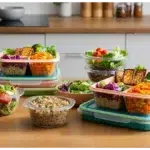
Vegetarian Meal Prep
Ingredients
Quinoa and Black Bean Salad
- 1 cup quinoa
- 1 can black beans, rinsed and drained
- 1 medium bell pepper, diced Any color
- 1 cup corn Fresh or frozen
- 1/4 cup red onion, finely chopped
- 1/4 cup cilantro, chopped
- 2 tablespoons olive oil
Vegetable Stir-Fry with Tofu
- 1 block firm tofu, pressed and cubed
- 2 cups assorted vegetables Broccoli, bell peppers, carrots, snap peas
- 2 tablespoons soy sauce or tamari For gluten-free
- 1 tablespoon sesame oil
- 1 tablespoon ginger, minced
- 2 cloves garlic, minced
Chickpea and Sweet Potato Curry
- 1 can chickpeas, rinsed and drained
- 1 medium sweet potato, diced
- 1 can coconut milk
- 1 tablespoon curry powder
- 1 teaspoon cumin
- 2 cloves garlic, minced
- 1 tablespoon olive oil
Mediterranean Pasta Salad
- 8 oz whole wheat pasta
- 1 cup cherry tomatoes, halved
- 1/2 cup cucumber, diced
- 1/4 cup red onion, finely chopped
- 1/2 cup Kalamata olives, pitted and sliced
- 1/4 cup feta cheese (optional)
- 3 tablespoons olive oil
- 1 tablespoon red wine vinegar
Lentil Soup
- 1 cup lentils, rinsed
- 3 cloves garlic, minced
- 6 cups vegetable broth
- 1 teaspoon thyme
Instructions
Quinoa and Black Bean Salad
- In a medium saucepan, mix the quinoa with 2 cups of water. Bring to a boil, then lower the heat, cover, and let simmer for 15 minutes.
- In a large bowl, combine cooked quinoa, black beans, diced bell pepper, corn, red onion, and chopped cilantro.
- In a small bowl, combine lime juice, olive oil, salt, and pepper. Drizzle over salad and mix well.
- Divide salad into meal prep containers. Can be stored in the refrigerator for up to 5 days.
Vegetable Stir-Fry with Tofu
- Press tofu to eliminate excess moisture by encasing it in a clean kitchen towel and placing a heavy object on it for 15 minutes.
- Heat sesame oil in a skillet over medium heat. Add cubed tofu, cooking until golden brown on all sides, around 8-10 minutes. Set aside.
- In the same skillet, add ginger and garlic, sauté for 1 minute. Incorporate vegetables and stir-fry for 5-7 minutes until tender-crisp.
- Combine everything and cook for another 2-3 minutes until warmed through.
- Serve over cooked brown rice or quinoa, portion into meal prep containers.
Chickpea and Sweet Potato Curry
- In a large pot, warm olive oil over medium heat. Add chopped onion and minced garlic, sautéing until translucent, about 5 minutes.
- Add diced sweet potato, curry powder, and cumin. Stir for 2 minutes to coat sweet potatoes with spices.
- Pour in coconut milk and add chickpeas, bringing to a simmer and cooking for 15-20 minutes until tender.
- Divide curry into meal prep containers and garnish with fresh cilantro before serving.
Mediterranean Pasta Salad
- Cook pasta according to package instructions. Drain and rinse under cold water.
- In a large bowl, combine cooked pasta, cherry tomatoes, cucumber, red onion, olives, and feta cheese if using.
- In a small bowl, combine olive oil, red wine vinegar, salt, and pepper. Pour over pasta salad and toss to combine.
- Store in meal prep containers. Lasts up to 4 days in the refrigerator.
Lentil Soup
- In a large pot, sauté onions, carrots, and celery in olive oil for 5-7 minutes until softened.
- Add garlic and cook for another minute. Stir in lentils, vegetable broth, thyme, bay leaf, salt, and pepper.
- Bring to a boil, then reduce heat and let simmer for 30-40 minutes until lentils are soft.
- Remove bay leaf, divide soup into containers. Can be stored in refrigerator or frozen for later.

